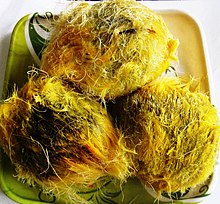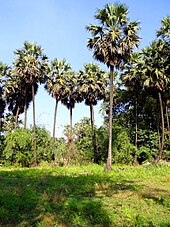Borassus flabellifer
This article should specify the language of its non-English content, using {{lang}}, {{transliteration}} for transliterated languages, and {{IPA}} for phonetic transcriptions, with an appropriate ISO 639 code. Wikipedia's multilingual support templates may also be used. (July 2022) |
| Borassus flabellifer | |
|---|---|

| |

| |
| Fruiting specimen | |
| Scientific classification | |
| Kingdom: | Plantae |
| Clade: | Tracheophytes |
| Clade: | Angiosperms |
| Clade: | Monocots |
| Clade: | Commelinids |
| Order: | Arecales |
| Family: | Arecaceae |
| Genus: | Borassus |
| Species: | B. flabellifer
|
| Binomial name | |
| Borassus flabellifer | |
| Synonyms[1] | |
Borassus flabellifer, commonly known as doub palm, palmyra palm, tala or tal palm, toddy palm, lontar palm, wine palm, ထန်းပင် (htan-pin) or ice apple,[2][3] is a fan palm native to South Asia (especially in Bangladesh, East India, and South India) and Southeast Asia.[4] It is reportedly naturalized in Socotra.[5][6]
Description
Borassus flabellifer is a robust tree and can reach a height of 30 metres (98 ft). The trunk is grey, robust and ringed with leaf scars; old leaves remain attached to the trunk for several years before falling cleanly. The leaves are fan-shaped and 3 m (9.8 ft) long, with robust black teeth on the
Uses
Fruit


The fruit (palmyra fruit) measures 10 cm (3.9 in) to 18 cm (7.1 in) in diameter, has a black
The conventional way this fruit is eaten is when the outer casing is still unripe while the seeds are eaten as the fruit. But if the entire fruit is left to ripen, the fibrous outer layer of the palm fruits can also be eaten raw, boiled, or roasted. When this happens, the fruit takes a purple-blackish hue and tastes similar to coconut flesh. The skin is also eaten as part of the fruit similar to how mango skins are often consumed along with the fruit. Bengalis have perfected the art of making various sweet dishes with the yellowish viscous fluid substance obtained from a ripe palm fruit. These include mustard oil-fried (alternately sunflower oil-fried) taler bora (তালের বড়া) "palmyra vadas" or mixed with thickened milk to prepare tal-khir (তাল ক্ষীর). Thais also use the fruit to make the steamed fluffy tala palm cake, call “Khanom Tan”.
In northern India, the fruit is known as Taad Gola in
-
Preparation of seeds in a road stall (Myanmar)
-
Toddy or palm wine collection pot, India
-
Edible jelly seeds of palmyra palm, Guntur
-
Vendor packing the seeds in a road stall, Visakhapatnam
Sap
Obtaining the sap traditionally involves tapping the top shoots and collecting the dripping juice in hanging earthen pots (in some regions a plastic or bamboo bottle). The juice collected in evening or after fermentation becomes sour, and is called tadi (ताडी) in
A sugary
In Thailand, there are techniques that utilize the anti-bacterial agents of some woods to keep the sap from becoming sour while tapping. After sterilization, the sap is available as a beverage called nam tan sod (น้ำตาลสด, lit. 'fresh tala palm water') or used to make an alcoholic beverage called nam tan mao (น้ำตาลเมา lit. 'drunken tala palm water'). “Nam tan”, literally means tala palm water, later acquired the meaning of “sugar “.
Sprouts
In the Indian states of
The germinated seed's hard shell is also cut open to take out the crunchy kernel, which tastes like a sweeter water chestnut. It is called "Taal-Anti" (তাল আঁটি) in Bengali, "Sachi-Htway" (ဆံချည်ထွေး) in
The white kernel of the ripe palm fruit after being left for a few months is used as an offering in Lakshmi Puja in various parts of Bengal and is also eaten raw.
In Thai cuisine, it is used as an ingredient to a type of curry, called “Kaeng Hua Tan”.
Leaves




The Borassus flabellifer leaves are used for
material.All the literature of the old Tamil was written in preserved palm leaves also known as Palm-leaf manuscript. In Tamil Yaedu or Olai chuvadi. Most of the ancient literature in Telugu are written on palm leaves (Tala patra grandhas).
In

The stem of the leaves has thorny edges (called "karukku" in Tamil).
The skin of the stem can be peeled off and be used as rope and also used to weave into cots (நார்க்கட்டில் in Tamil). In some part of Tamil Nadu, a variety of rice flour cake (called "Kozhukattai") is prepared using the leaf.
In the eastern part of India, the leaves are used to make hand fans. In Myanmar, the leaves are used to make hand fans for the Buddhist monks and are called "Yap" (ယပ်).
Trunk
The
Crown
When the crown of the tree is removed, the segment from which the leaves grow out is an edible cake. This is called htan-ohn-hnauk (ထန်းဦးဏှောက်) in
Roots
In Cambodia, where the palm is known as thnôt' (Khmer), the roots are dried and smoked to heal nasal complaints.[12]
Cultivation
Borassus flabellifer has a growth pattern, very large size, and clean habits that make it an attractive
palm species.Cultural symbolism

- The palmyra tree is the official tree of Tamil culture, it is called "katpaha tharu" ("celestial tree") because all its parts have a use. Panaiveriyamman, named after panai, the Tamil name for the Palmyra palm, is an ancient tree deity related to fertility linked to this palm. This deity is also known as Taalavaasini, a name that further relates her to all types of palms.[13]
- The Asian palmyra palm is a symbol of Cambodia where it is a very common palm, found all over the country. It also grows near the Angkor Wat temple.[14]
- In Indonesia the Palmyra tree is the symbol of South Sulawesi province.
- This plant has captured the imagination of Rabindranth Tagore whose nursery rhyme 'Tal Gach ek Paye dariye' (তাল গাছ এক পায়ে দাড়িয়ে.., literally Palmyra tree standing on a single leg ... ) in Sahaj Path (সহজ পাঠ) is a staple reading material in schools in Bangladesh and West Bengal.
- In the Bheeshmaand Balarama.
- In Myanmar, the tree is the symbol of Anyar (အညာ) (the dry zone of Myanmar), and is called "pa-de-thar-pin" (ပဒေသာပင်) meaning the tree from which anything you wish can be taken. There are many poems and traditional sounds related to this tree.
- Sunthorn Phu, Thailand’s eminent bard of the Early Bangkok Era, mentioned the plant in many of his poems.
See also
References
- ^ The Plant List, Borassus flabellifer Mart.
- ^ "Borassus flabellifer". Germplasm Resources Information Network. Agricultural Research Service, United States Department of Agriculture. Retrieved 4 Aug 2016.
- ^ T.K., Lim (2012). Edible Medicinal and Non-Medicinal Plants: Volume 1, Fruits. p. 293.
- ^ Philippine Medicinal Plants, "Palmira"
- ^ Borassus flabellifer Kew World Checklist of Selected Plant Families, Royal Botanic Gardens, Kew
- ^ a b Bayton, Ross P. (2007). "A revision of Borassus L. (Arecaceae)". Kew Bulletin. 62: 561–586.
- ISSN 2949-8244.
- .
Pipatchartlearnwong, Kwanjai; Swatdipong, Akarapong; Vuttipongchaikij, Supachai; Apisitwanich, Somsak (2017-10-12). "Genetic evidence of multiple invasions and a small number of founders of Asian Palmyra palm (Borassus flabellifer) in Thailand". S2CID 1386230.
- ISBN 9788189422523.
- ^ S. Wojowasito (1977). Kamus Kawi-Indonesia. Malang, Jawa Timur: Penerbit CV Pengarang. p. 226, 258.
- ^ "Logo dan Lagu" (in Malay). Dewan Bahasa dan Pustaka Malaysia. Retrieved 10 June 2024.
- ^ Pauline Dy Phon (2000). Plants Utilised In Cambodia/Plantes utilisées au Cambodge. Phnom Penh: Imprimerie Olympic. p. 22.
- ^ Heinrich Zimmer, Myths and Symbols in Indian Art and Civilization. (1946)
- ^ "The Cambodian palm tree". Archived from the original on 2019-02-10. Retrieved 2020-07-05.





